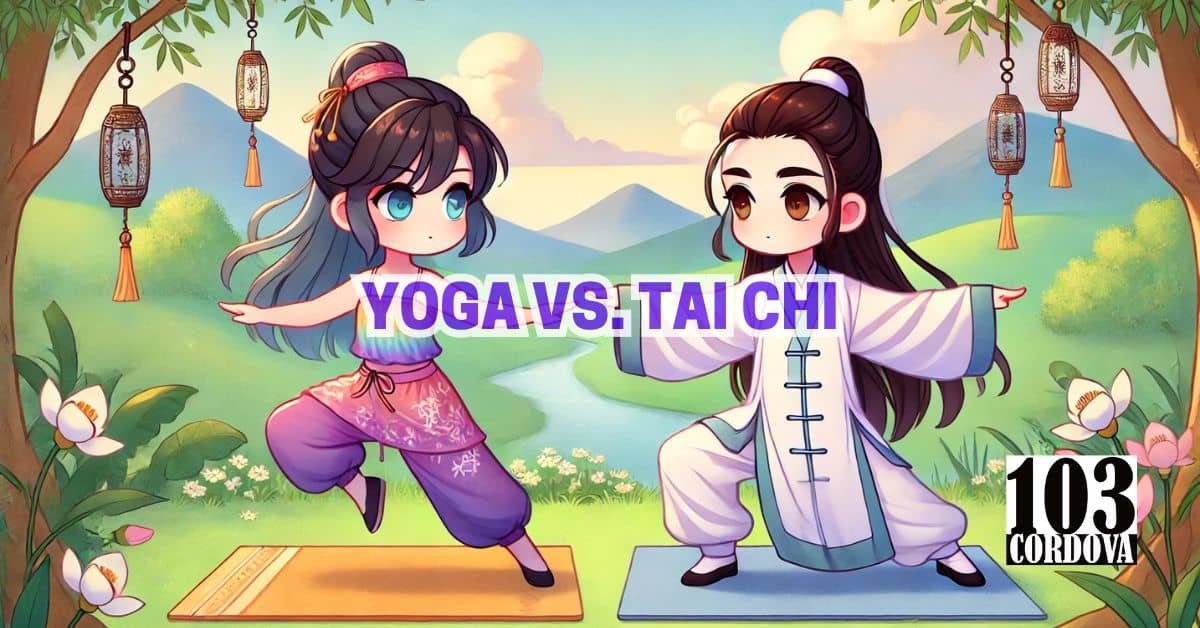Yoga and Tai Chi are two ancient disciplines that promote overall well-being.
Yoga originated in India thousands of years ago, with a focus on physical postures (asanas), breathing techniques (pranayama), and meditation to unite body and mind.
Tai Chi, developed in China, emphasizes slow, flowing movements aimed at enhancing energy flow (qi) and improving balance.
While both practices are considered forms of “moving meditation,” their underlying philosophies and movement styles differ significantly.
Understanding these differences can help you determine which practice aligns best with your personal goals and lifestyle.
1. Comparing the Physical Benefits of Yoga and Tai Chi
Yoga is renowned for improving strength, flexibility, and muscle tone through various postures that engage the entire body.
Regular practice helps build core stability and enhances joint mobility, making it suitable for people seeking greater physical conditioning.
Tai Chi, on the other hand, focuses on fluid, low-impact movements that are gentle on the joints and are especially beneficial for improving balance and coordination.
While Yoga tends to focus on individual muscle groups during postures, Tai Chi emphasizes full-body movement and the continuous flow of energy.
Both practices offer physical benefits, but yoga may be more intense, whereas Tai Chi provides a gentler, more holistic approach to movement.
🧘 Finding the Right Yoga Class for Kids in Marikina: What Parents Should Look For
2. Mental and Emotional Well-Being: Yoga vs. Tai Chi
Both yoga and tai chi have a profound effect on mental and emotional health, but they approach it in slightly different ways.
Yoga often incorporates breath control and meditation as central components, helping practitioners reduce stress and increase self-awareness.
The breathwork in yoga is designed to calm the nervous system and foster mindfulness, leading to a greater sense of inner peace.
Tai Chi’s slow, deliberate movements naturally promote a state of relaxation, lowering stress levels and promoting emotional balance.
While both practices can help manage anxiety and improve focus, yoga may offer more opportunities for structured meditation, whereas Tai Chi offers relaxation through movement.
🧘 How a Yoga Class for Kids Can Enhance Social Skills and Friendships
3. Exploring Different Styles: Yoga and Tai Chi Variations
Both yoga and tai chi come in various styles, each with unique approaches.
Yoga has diverse styles such as Hatha, which is gentle and slow-paced, or Ashtanga, which is more vigorous and demanding.
Vinyasa Yoga, known for its dynamic flow between postures, differs from Yin Yoga, which emphasizes long, passive holds.
Tai Chi also offers variations, like the slow and flowing Yang style or the more physically demanding Chen style, known for its faster and explosive movements.
These variations allow both yoga and tai chi to be adapted to individual fitness levels, goals, and preferences.
🧘 Joining a Yoga Class for Seniors in Marikina: The Importance of Community
4. Accessibility for Beginners: How Easy Is It to Learn?
Both yoga and tai chi are accessible to beginners, though they offer different learning experiences.
Yoga can be challenging at first, especially if you lack flexibility or strength, but many classes are tailored to beginners with modifications for each pose.
Tai Chi’s slow, gentle movements are generally easier to follow, especially for those with limited mobility or those looking for a low-impact practice.
While Yoga may require more time to learn proper alignment and build physical endurance, Tai Chi’s emphasis on continuous, flowing motions allows beginners to engage without feeling overwhelmed.
Both practices provide options to start at your own pace, making them accessible regardless of your current fitness level.
🧘 Choosing the Right Yoga Class for Seniors: Tips for Finding Your Perfect Fit
5. Enhancing Mobility and Rehabilitation: Which Practice Helps More?
Yoga is commonly used in rehabilitation settings to improve flexibility, build strength, and address specific physical limitations.
Certain postures in yoga target tight muscles and areas prone to injury, such as the lower back, hamstrings, and shoulders, making it a popular choice for recovery.
Tai Chi, known for its emphasis on balance and joint health, is often recommended for older adults or individuals recovering from injury, particularly because it involves slow, controlled movements that reduce the risk of strain.
While both practices can enhance mobility, yoga may be more intense for those recovering from injury, while Tai Chi offers a more gentle approach that supports gradual improvement in joint function.
Choosing between the two depends on the level of mobility and physical condition.
🧘 Is Yoga Aerobic Or Anaerobic Cellular Metabolism? Understanding the Science Behind Your Practice
6. Spiritual Elements: The Philosophy Behind Yoga and Tai Chi
Yoga’s spiritual foundation is deeply rooted in ancient Indian philosophy, particularly the concept of uniting the mind, body, and spirit to achieve a state of harmony and self-awareness.
Practices like meditation, breath control, and moral guidelines (yamas and niyamas) are integrated to support spiritual growth.
Tai Chi, rooted in Taoist philosophy, focuses on balance and the flow of qi (life energy), seeking harmony between opposing forces (yin and yang).
The goal of Tai Chi is to cultivate internal energy and balance within the self and the environment.
Both Yoga and Tai Chi offer spiritual elements, but Yoga may present more structured philosophical teachings, while Tai Chi focuses on harmony through movement and energy flow.
🧘 Is Yoga Aerobic Or Anaerobic Exercise? Comparing It to Traditional Workouts
7. Building Community: The Social Aspects of Yoga and Tai Chi
Yoga classes often foster a sense of community, where practitioners can share experiences, support each other’s progress, and connect over a shared interest in well-being.
Group classes, workshops, and retreats provide ample opportunities to interact with others in a supportive, non-competitive environment.
Tai Chi, particularly when practiced in a group setting, also builds social connections as participants move together in synchronized sequences, creating a unique sense of unity and collaboration.
While yoga communities may focus more on mindfulness and personal growth, tai chi groups emphasize collective energy and the flow of movement.
Both practices can build a strong sense of community, offering opportunities for social connection and shared practice.
🧘 Is Power Yoga Aerobic Or Anaerobic? A Deep Dive into Its Health Impacts
8. Time Commitment: How Much Time Do You Need for Each Practice?
Yoga and Tai Chi both offer flexible time commitments, depending on your schedule and goals.
A typical yoga session lasts between 60 and 90 minutes, but shorter practices, such as 15 to 30-minute flows, are also common, allowing for a variety of scheduling options.
Tai Chi sessions can be as brief as 15 minutes, focusing on short sequences, but longer, more in-depth sessions may range from 30 minutes to an hour.
Yoga may require more time if you are working through multiple postures, while Tai Chi can be more time-efficient due to its continuous movement style.
The choice depends on how much time you can dedicate, with both practices offering adaptable routines to fit different lifestyles.
🧘 Is Hot Yoga Aerobic or Anaerobic and How It Affects Your Body
9. Finding the Right Fit: Personal Preference in Choosing Your Practice
Choosing between yoga and Tai Chi often comes down to personal preference and what resonates with your body and mind.
If you enjoy a dynamic, physically challenging routine that incorporates stretching, strength-building, and breathwork, yoga may be more suited to your needs.
On the other hand, if you prefer a gentler, flowing practice that emphasizes relaxation and coordination without intense physical demands, Tai Chi might be a better fit.
Additionally, consider whether you are drawn to the spiritual and meditative aspects of yoga or the energy-balancing and calming effects of Tai Chi.
Trying both practices can help you decide which one aligns better with your personal goals and lifestyle.
🧘 What Does Yoga Help With? Transforming Your Life Through Mindfulness
10. Which Practice Suits Different Life Stages and Health Conditions?
Yoga is highly adaptable and can be modified to accommodate various life stages, including pregnancy, injury recovery, and aging, with specific styles like prenatal yoga or restorative yoga available for different needs.
Tai Chi, with its low-impact, slow movements, is particularly well-suited for older adults or individuals with limited mobility, as it emphasizes balance and gentle joint movement.
Younger people may enjoy the physical challenge of yoga, while older adults often find Tai Chi more accessible.
Both practices can be tailored to different health conditions, but Tai Chi’s gentleness makes it a popular choice for rehabilitation and maintaining mobility in later life.
Choosing the right practice depends on your age, physical abilities, and long-term health goals.
🧘 How to Prepare for Your First Yoga Class for Beginners in Marikina
💡 Conclusion
Ultimately, the decision between yoga and tai chi depends on your individual needs, lifestyle, and preferences.
Yoga provides a more physically demanding practice that integrates strength, flexibility, and meditation, appealing to those seeking a deeper connection between body and mind.
Tai Chi offers a softer, more meditative approach focused on balance and energy flow, making it ideal for people looking for a gentle, calming practice.
Both practices offer profound physical and mental benefits, so the best way to choose might be to try each and see which one aligns with your goals and resonates with you.
Whether you choose Yoga, Tai Chi, or both, incorporating these practices into your life can significantly enhance your overall well-being.
🧘 Our Services
Discover our yoga classes for all ages at 103 Cordova Tower, Marquinton Residences, Sto. Nino, Marikina City.
Whether you’re a beginner or experienced practitioner, we offer sessions tailored to your needs, promoting flexibility, strength, and relaxation.
Our welcoming environment is perfect for individuals and families looking to improve their well-being through yoga.
For more information, contact us at 09176225780, reach out through Facebook, or use our site’s contact form.
Join us today and start your journey to a healthier, more balanced life!

